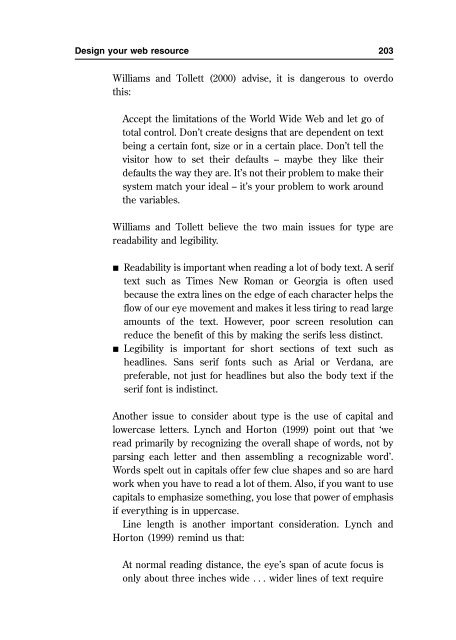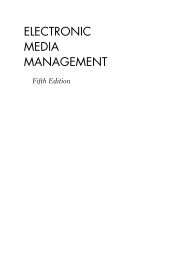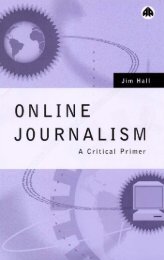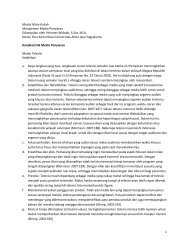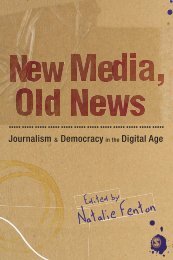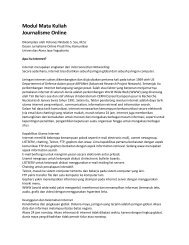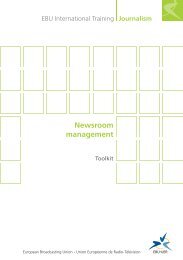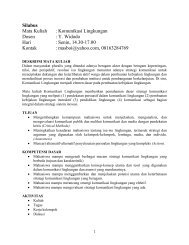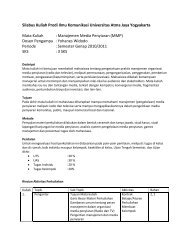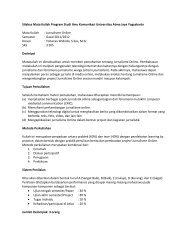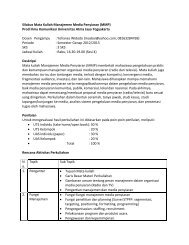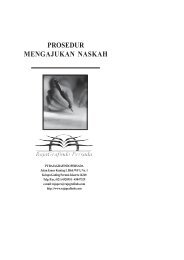1What is online journalism? - Ayo Menulis FISIP UAJY
1What is online journalism? - Ayo Menulis FISIP UAJY
1What is online journalism? - Ayo Menulis FISIP UAJY
Create successful ePaper yourself
Turn your PDF publications into a flip-book with our unique Google optimized e-Paper software.
Design your web resource 203<br />
Williams and Tollett (2000) adv<strong>is</strong>e, it <strong>is</strong> dangerous to overdo<br />
th<strong>is</strong>:<br />
Accept the limitations of the World Wide Web and let go of<br />
total control. Don’t create designs that are dependent on text<br />
being a certain font, size or in a certain place. Don’t tell the<br />
v<strong>is</strong>itor how to set their defaults – maybe they like their<br />
defaults the way they are. It’s not their problem to make their<br />
system match your ideal – it’s your problem to work around<br />
the variables.<br />
Williams and Tollett believe the two main <strong>is</strong>sues for type are<br />
readability and legibility.<br />
Readability <strong>is</strong> important when reading a lot of body text. A serif<br />
text such as Times New Roman or Georgia <strong>is</strong> often used<br />
because the extra lines on the edge of each character helps the<br />
flow of our eye movement and makes it less tiring to read large<br />
amounts of the text. However, poor screen resolution can<br />
reduce the benefit of th<strong>is</strong> by making the serifs less d<strong>is</strong>tinct.<br />
Legibility <strong>is</strong> important for short sections of text such as<br />
headlines. Sans serif fonts such as Arial or Verdana, are<br />
preferable, not just for headlines but also the body text if the<br />
serif font <strong>is</strong> ind<strong>is</strong>tinct.<br />
Another <strong>is</strong>sue to consider about type <strong>is</strong> the use of capital and<br />
lowercase letters. Lynch and Horton (1999) point out that ‘we<br />
read primarily by recognizing the overall shape of words, not by<br />
parsing each letter and then assembling a recognizable word’.<br />
Words spelt out in capitals offer few clue shapes and so are hard<br />
work when you have to read a lot of them. Also, if you want to use<br />
capitals to emphasize something, you lose that power of emphas<strong>is</strong><br />
if everything <strong>is</strong> in uppercase.<br />
Line length <strong>is</strong> another important consideration. Lynch and<br />
Horton (1999) remind us that:<br />
At normal reading d<strong>is</strong>tance, the eye’s span of acute focus <strong>is</strong><br />
only about three inches wide . . . wider lines of text require


